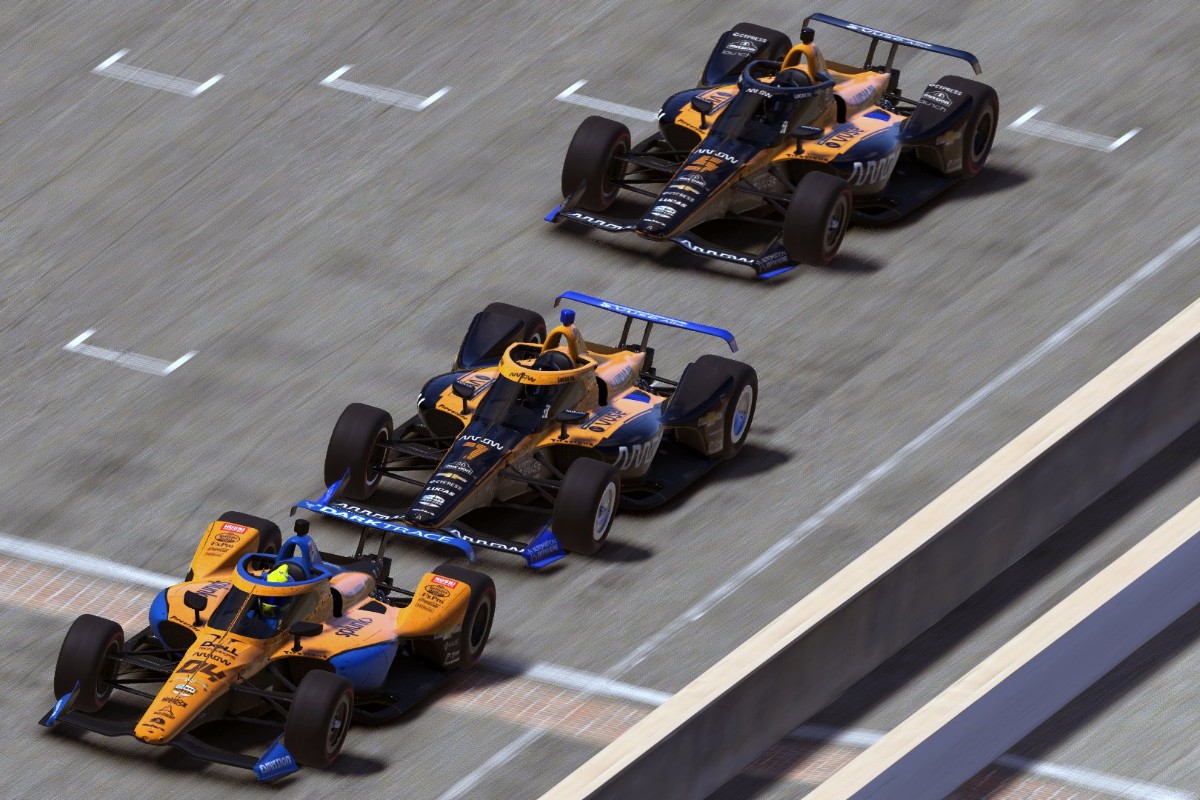
Photos: McLaren
Three of the most exciting young drivers of the last few years have returned McLaren to the front in IndyCar. It may only be in Esports, but, as the trio explain, that winning form could soon be seen in the real world too
The combined age of McLaren Schmidt Peterson’s three-car line-up for the 175-mile IndyCar iRacing Challenge race at Indianapolis Motor Speedway on iRacing was 63 years old. Between them they already had eight single-seater titles, 86 wins and 83 poles.
On lap 68 of 70, those three cars were leading the race, and it was not by chance. Formula 1 star Lando Norris was at the front towing along reigning Indy Lights champion Oliver Askew, with fellow champion Patricio O’Ward just behind.
“It felt really cool [leading]. I was super excited, I was like ‘come on guys, lets just keep it 1-2-3’, and I was cruising at the back trying to block the guys in the pack so they wouldn’t get in the middle of us,” O’Ward told Formula Scout.
“Before that I was in the pack, trying to stay out of trouble. But whenever it came to hammer time I was passing people, being aggressive. I was going to go for the win on the last lap. It was cool to race with my team-mates first, 1-2-3 with five laps to go. But then Simon Pagenaud took out Lando, and just me and Oliver were battling it out [so] people caught up.”
The deliberate elimination of Norris broke McLaren’s defensive plan, but they were still on for victory until further chaos.
“Our strategies were very similar, and I think we had the best strategy – as you could tell at the end of the race – compared to other cars,” added Askew. “It was a matter of us being smart and realising we were 1-2-3, and thinking about how big this is for the team rather than just us drivers trying to win the race [for ourselves]. It was best for us to not be so selfish.
“It would have been very easy for us to finish one-two at least, so, once [Norris’s crash] happened, cars behind us had a shot at finishing on the podium.”

How Norris’s victory hopes ended
First of those was Marcus Ericsson, who’d left SPM for Chip Ganassi Racing at the end of 2019. O’Ward picks up the story.
“Marcus came, we gave Marcus room, and whenever I dove in to pass him back he didn’t give me room, but there was plenty of space for him to. I know you can’t do that [move] at Turn 4 in real life, but in iRacing you can and it will be just fine. You can even go three-wide and no one will crash if you maintain your line. My wing was there, and it was the last lap. Who in the world is going to release the throttle. [If you do] you’re not going to win. I said: you know what, either I win or I put myself in the wall.”
Askew took back the lead until the final seconds, when he was punted by Santino Ferrucci and finished the race several feet up in the air and in fourth place. O’Ward was a few tenths behind in fifth, while Norris finished a lap down in 21st place.
“The drivers, sponsors, teams, strategists and the personnel have all been taking it very seriously. This is way more than [a game]. There’s still a lot of money involved, and for someone to go in and act so carelessly and so selfishly towards this format is very disrespectful towards us drivers, the teams, sponsors and IndyCar,” was Askew’s response to Ferrucci’s move.
That’s the controversial end to IndyCar’s Esports finale out of the way, now down to why McLaren SP is on for real success.
Team boss Sam Schmidt, whose SPM team merged with F1 team McLaren over winter, is the man most likely to know why.
“Everybody has a lot of self-motivation here, including the drivers. These two kids are outstanding talents,” said Schmidt. “In bringing on McLaren and merging that whole situation, we have to bring their technical support up to speed. It’s probably going to take six months to start seeing any benefit from that. [Overall] …there is a lot of processes to be set up.”
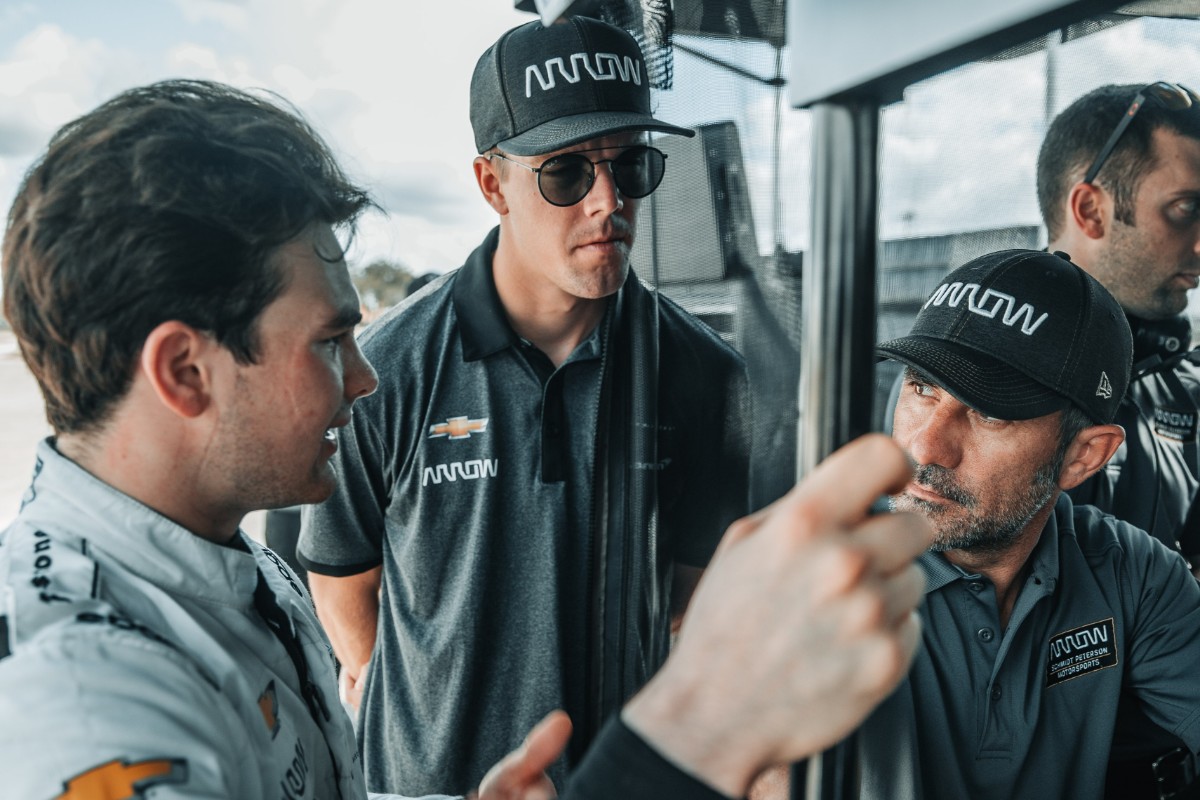
That F1 incorporation included Norris’s 2019 engineer Andrew Jarvis, who was initially set to join the American side for the now delayed Month of May but reunited with the Briton when he joined the IndyCar Challenge at Circuit of the Americas (and won). There are some hires from IndyCar rivals, as well as the F1 colleagues who failed to qualify for the Indianapolis 500 last year in a solo effort driven by Fernando Alonso and will no doubt find the Esports races, even through observation, useful in Schmidt’s target for them to get “up to speed” on both American racing and the new F1-mirroring personnel layout.
“So far, communication, effort, and willingness to work together has been very positive. When you put it all together, you can’t be ignorant of the fact that there are some outstanding teams and some really good drivers that we’ll be facing [on track].”
O’Ward and Askew, both new to simulator racing, confirmed the immersion of the team in the online racing event.
“We had race engineers [Will Anderson and Blair Perschbacher] and performance engineers, and the data analysts. Five or six people working on all kinds of data and strategy,” said O’Ward.
Askew, new to the scale of an IndyCar outfit, found it very beneficial: “It’s [about] getting used to working with the guys. It’s different for those who’ve been doing this for a while, [for them] it might just turn into an exercise, but for me it’s been really vital to get the most out of it.”
Alonso is the only of McLaren SP’s Indy 500 line-up this year with experience of the race, and so the strategy work in Esports will undoubtedly prove useful for all involved. And unlike McLaren’s last ambitious but ill-fated partnership, a Honda F1 engine supply that began in 2015 and only lasted three years, communication seems to be going fine.

While it is ‘just’ a simulation, the fact that McLaren SP is already rivalling Team Penske for nailing race management is a good sign. As for whether the speed is relatable too, Norris is an iRacing expert and many IndyCar drivers have pointed out the stark difference in the fixed set-up physics model for the Dallara IR18 (with aeroscreen) and its Firestone tyres, and the real thing. A tweak to in-game air temperature also meant wind at Indy was minimal, distancing the handling realism that little bit further.
Norris led O’Ward in a one-two on his COTA debut, despite a spin, and his arrival helped his team-mates understand the set-up intricacies of simulators. This was an under-the-radar landmark moment; O’Ward is not shy in admitting his cautions about simulator use, even when facing new circuits and equipped with a multi-million pound F1-level rig rather than a home setup. After all, Red Bull put him in a real F1 car rather than the sim last year to decide if they wanted him as a junior, and McLaren is undeniably taking a huge risk in starting its brave new partnership with a line-up that has accumulated nine IndyCar starts.
Having that extra understanding of simulators, aided also by a full day in Woking’s high-spec rig, will prove valuable in a broader sense back in the McLaren SP factory – and the second technical group over in the UK – for the rest of 2020.
“We have the personnel, the data and the software to be able to correlate the car to the simulator at Chevrolet’s [motion rig] in North Carolina,” explained Askew. “And we have seen that, even in pre-season, being able to correlate to the real-life car and then back to the simulator. It’s opened the eyes of our data and performance engineers.”
Askew was seventh in the pre-season COTA test and gained mileage at the Texas oval due to being a rookie, while O’Ward was 10th at COTA and Sebring. Despite cold weather shortening track time, both were pleased. The COTA runs were “a really, really good sign for what’s to come” according to Askew, and O’Ward was “finally feeling ‘in it'” on qualifying and race stints there.
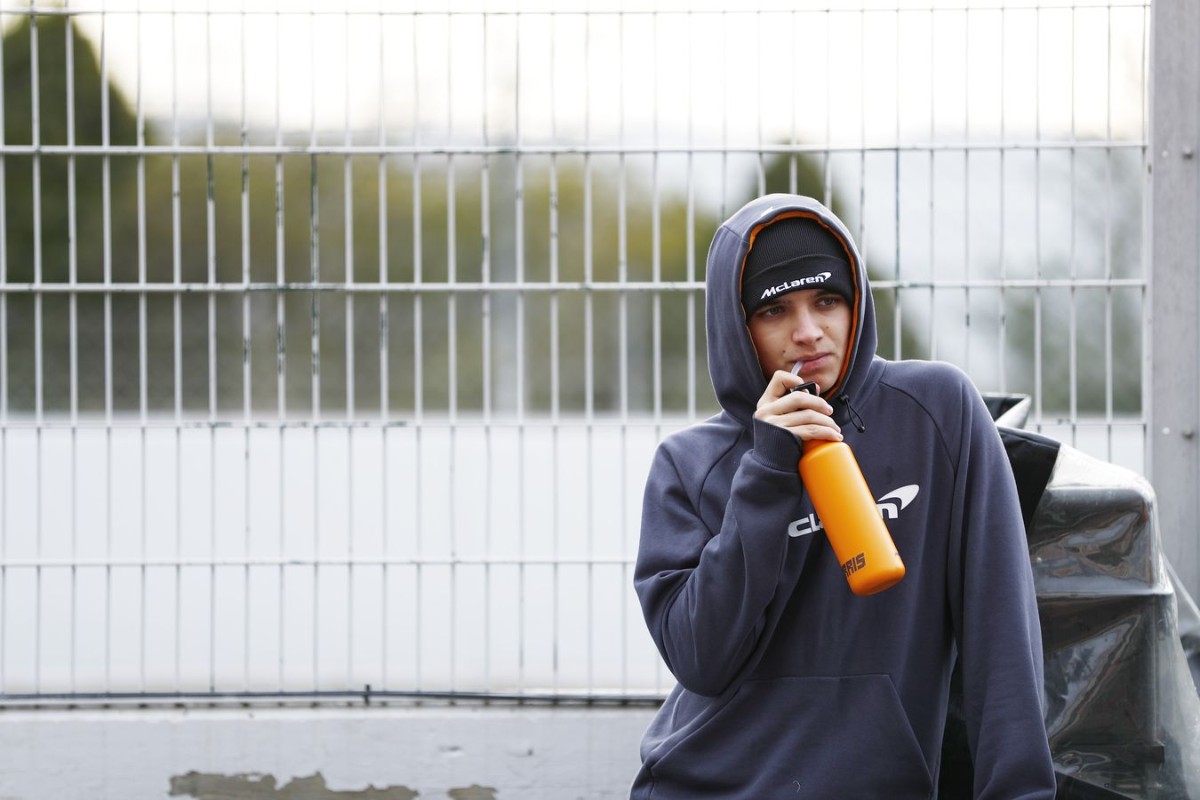
The only McLaren driver to top the times at COTA, virtually at least, was IndyCar rookie Norris. He took Esports pole by 0.396 seconds, then beat a “proud” O’Ward to victory by 1.445s. At Indy he was 0.007s (0.04mph) off pole, and led 12 laps before his crash with Penske’s Pagenaud. That form came despite no oval experience, meaning he learned to read the grip change on ageing tyres and how much to lift over a stint, and the risks of pack racing, in the days before. While he is one of the best on iRacing, his home setup has been custom built to be as realistic and applicable to a high-downforce single-seater as possible.
“Do you know how many hours I’ve spent doing this?” said a frustrated Norris after finishing the Indy race. “24 hours in total I reckon I must have spent driving in a straight line and turning left, and trying to perfect it.”
“With the most delicate touch. I’ve tried doing it one handed, I’ve tried doing it with my knee. 24 hours!
“And then because that guy gets a bit salty that a non-IndyCar driver is about to win an Indy race, he just ruins it.”
Norris jokes, as do all of McLaren’s drivers, but he’s serious about the amount of work he’s put into his virtual Indycar venture.
“I feel so bad for the [other McLaren] guys. Maybe some people aren’t taking it seriously… but there are still a lot of other drivers – like I had Jarv and the engineers and the guys doing strategy, and we still put time into it.”
Even at COTA there was a noticeable improvement curve for Norris in the run up to the race, and the fact his team-mates joined him at the front of the field in the last two races as they worked together is even greater proof of his hard work. The trio’s maturity in the ‘race weekends’, most visible while leading at Indy, is the brand-positive message McLaren desires.
Norris is already used to that kind of pressure in F1, and given McLaren SP is pursing F1 levels of simulation and engineering capacity, it’s introduced F1 levels of brand representation to IndyCar too since announcing its drivers in October.

Over the four months after being revealed as McLaren’s line-up at the end of October, O’Ward estimates he clocked up around 70 flights for work. Unsurprisingly he described the experience as “exhausting”, and one leg of the Mclaren SP ‘tour’ involved: “going to London and then I had to go out of town to get something done with my passport, then I had to return to Charlotte for the sim, and then we had an appearance in Arizona. I have never been so crazy like on the road.”
The highlight was visiting the McLaren Technology Centre, where each driver spent a day in the sim doing laps of Barcelona in an F1 car. While the building may be 6359km away from the Indiana HQ, the expertise there is available at a moment’s notice.
Harder even than the gruelling media tour has been staying race-fit while an extra two months has been added to pre-season due to the coronavirus pandemic; the fully equipped gyms are all shut, and the carefully curated racing driver diets have been interrupted by decreased access to shops. O’Ward is based in Texas, while Askew has moved to Indiana for this year.
The IndyCar Challenge has helped with staying in the competitive mindset needed in elite sport, the kind of mindset that leads to drivers spending their free time training and looking through data rather than succumbing to boredom, and Askew has been fortunate to get in some development work of rival Will Power’s new kart (in a safe environment). It’s keeping him sharp, attuned to the actual sensation of speed rather than the virtual one, and importantly keeping his neck muscles active.
The nearest kart track to O’Ward is four hours away, and he admits smaller neck muscles is a worry that he’s working around.
“Physically I’ll be fine, I’m training harder than ever. The first two weeks of quarantine I took it easy, put on a little bit of weight. Not to my liking.” McLaren probably wasn’t happy either. “I’ve been training twice a day [since], five days a week, and am back to where I was. Actually I’m below where I was, so I’m proud about that. But the neck is going to be the toughest to retrain.”
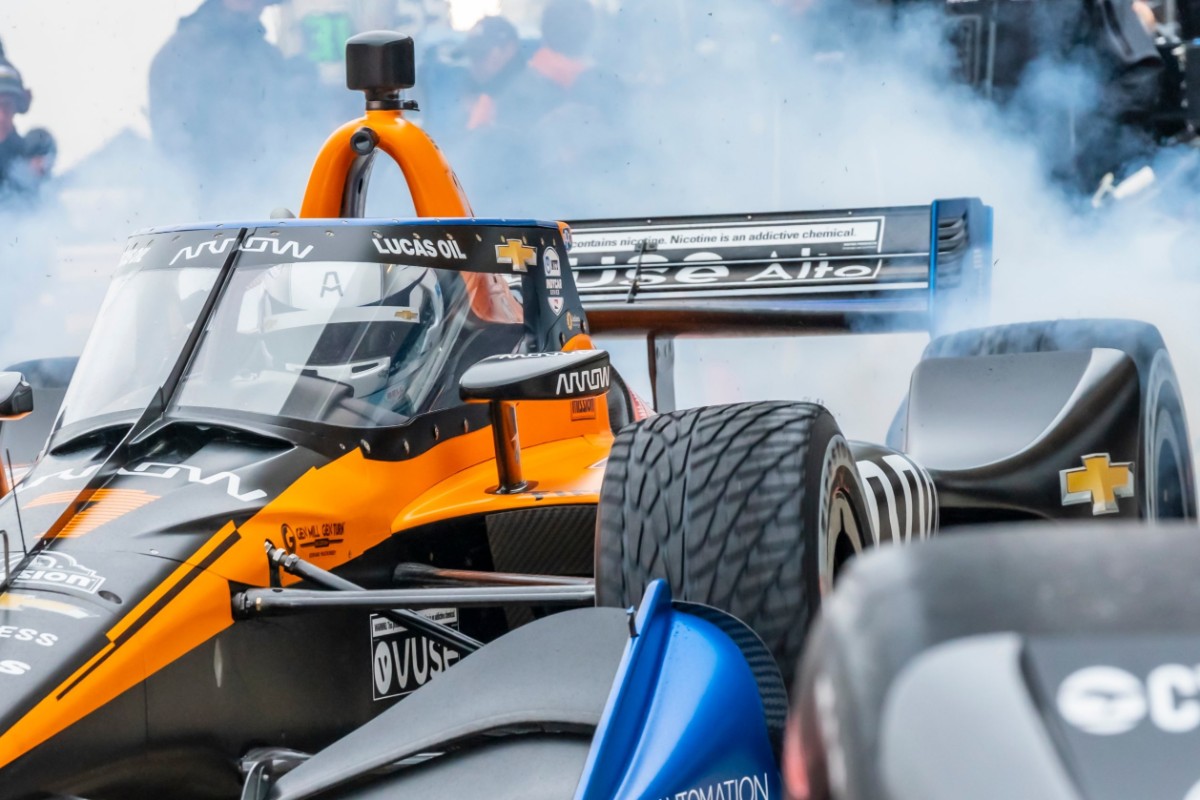
Askew has also increased his training regime, and fulfilled a lengthy ambition of having a top-end road bike. Keeping at the same level of fitness is hard enough in these odd times, and to let it slip but then come back better than ever is commendable.
The fitness element is even more important for Norris, who at 170cm is the shortest of the three and therefore has the least muscle mass, as F1’s 2020 cars are expected to be the fastest ever at some circuits. He expects that going from no driving at all to being back in an F1 car to be “a shock to the body”, comments he shared in an Instagram livestream with F1.
“To be able to go from doing nothing – not even testing or driving an Formula 3 car or any car of any sort – to jumping in to one of the fastest cars in the world, pulling x amount of g-forces around the corners. It’s a big shock”, said the 20-year-old.
There could be some sliding doors in McLaren’s line-up in the coming years. F1 world champions Alonso and Jenson Button are as interested as Norris in tackling IndyCar away from the ovals, while O’Ward and Askew are definitely on the F1 radar.
“[Alonso at Indy] is going to be awesome,” enthused Askew. “Obviously it’s a shame we weren’t able to do that in the Month of May, but it will happen come August. We’ll find a way to make the race happen. Fernando has been an idol of mine and an idol to a lot of [professional] drivers. Just having his presence in the paddock and as a team-mate, it’s inspiring. I can’t wait to see how he works around the engineers and how he manages a race weekend. I think Pato and I will learn a lot from him.”
It looks like McLaren SP won’t necessarily need Alonso to form a winning IndyCar line-up, and the youthful face of the brand is now completed by Norris rather than the bearded Spaniard. A reunion with Norris is just as appealing to Askew:
“I think Lando’s a tremendous talent, he brings a lot of eyes to his racing. I’m sure it will be, if he decides to do it one day, a big help to IndyCar and the team.”
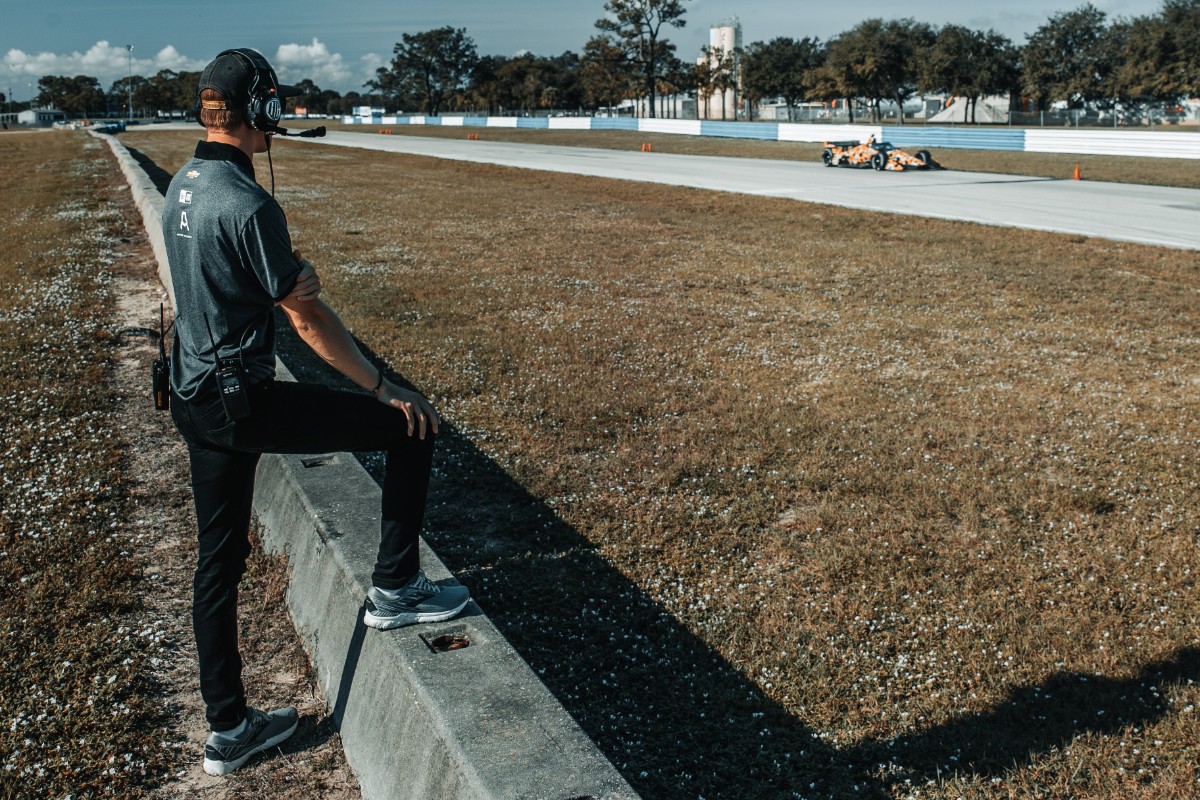
McLaren’s secret (weapon) driver
McLaren SP had a third car out in the IndyCar Challenge before Norris’s arrival, and it took pole and finished fifth at Twin Ring Motegi. The man behind the wheel was Robert Wickens, who raced for SPM as a rookie in 2018 until a horror crash at Pocono that broke bones in his arms, legs, chest neck and spine and left him paraplegic. His recovery since has been inspiring.
A seat at the team is technically reserved for the 31-year-old Canadian for when he is able enough to return to a real life Indy car, and he has already gained enough strength and control in his lower body during rehabilitation that he was able to walk, cycle (on a static bike), dance and drive a specially adapted car within a year of his accident against all odds.
Wickens, Formula Renault 3.5 champion in 2011, could potentially totally overcome his disability before being back in the cockpit. For now, he has settle with being a driver coach tasked with getting the most from his team-mates’ contrasting styles.
Askew explained the relationship with Wickens, whose junior career also included second places in GP3 and Formula Two.
“Robbie really understands where I come from, and where my experience comes from. We’ve known each other for a couple of years now. It’s very cool for him to sit in the background and listen to what’s going on, and watch my telemetry and my sessions and see how I progress and manage a race weekend. I think that’s definitely where his expertise is going to come in.”
Wickens took pole and almost won on his own IndyCar debut, and claimed four podiums before his crash.
“Having Robert there day-in and day-out is pretty critical to our success,” explained Schmidt. “Robert, with six years of DTM, where they turned over every rock and screw to make those cars and drivers faster. Him coming in and being there for the test days and for the race weekends is invaluable to those drivers.”
“That,s one of the reasons, among many others, that we are so excited to bring in Fernando [too] because his reputation is of total preparation. No rock unturned. He wants to make the car fast, he wants to make the team better and he wants to win.”